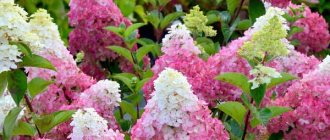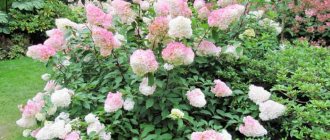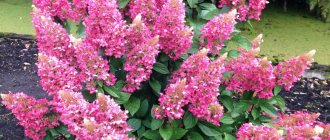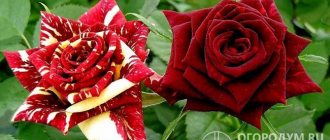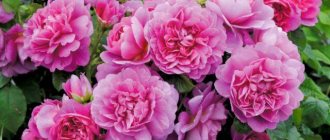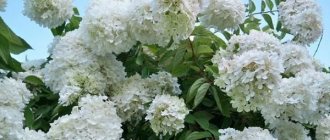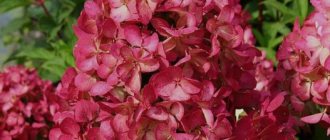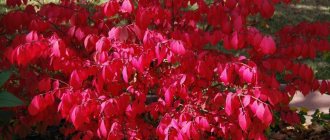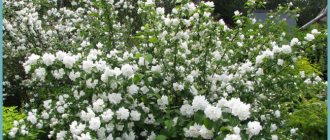History of selection
The Hydrangea paniculata variety Sunday Fries was bred through selection in the French nurseries Renault and Sapho by Jean Reno and introduced into commercial circulation in 2010.
The Sunday Fraise variety was obtained from the previously bred Vanille Fraise variety and is distinguished by its height and compactness.
In 2010, the Sundae Fraise variety was awarded a silver medal at the International Plantarium Exhibition (Boskop Netherlands). The variety is patented; reproduction without paying for a license is punishable by law.
Conditions for keeping containers in winter
- in cool basements, temperature ranges from 0 to 5 °C
- bury the container in the garden in the ground so that the base of the plant is approximately 5-6 cm below the surface of the ground to make a mound of soil above it;
- on the terrace, place the container with the plant on dense polystyrene foam at least 10 cm thick, surrounding it with equally thick multi-layer cardboard or plywood, tie it with rope and fill the empty spaces with non-absorbent filler, for example, foam chips. In autumn, before frost sets in, water abundantly.
Hydrangea paniculata Sunday Fries is recommended for garden plots and, due to its size, is also suitable for growing in containers.
Description of hydrangea Sunday Fries
Hydrangea Sundae Fraise belongs to the category of new varieties. But at the same time, it has already gained wide popularity not only among landscape designers, but also among amateur flower growers. This was due to the high decorative qualities of the plant and its relative ease of care.
Hydrangea Sunday Fries is characterized by compact bushes
Hydrangea paniculata Sunday Fries has French roots. She was bred thanks to the efforts of Jeannot Reno. His goal was to obtain a compact perennial shrub with delicate, elegant inflorescences. And he managed to do this about 10 years ago.
Detailed description
Sunday Fraise (paniculata sundae fraise) is a hydrangea variety that blooms from mid-June to September (in the south - until October). It produces lush, very beautiful flowers (diameter up to 2.5 cm) of white, light and deep pink shades with openwork petals. Moreover, light flowers appear first, then they become soft pink, after which they acquire the brightest color.
This variety was bred in 2010, but within a few years Sunday Fries managed to spread widely, including in Russia. The bush has a thick, beautiful crown of dark green shades. The leaves are large, growing up to 10-12 cm in length. At the same time, they are narrow, look miniature and serve as an excellent background for lush inflorescences.
Hydrangea Sunday Fries reaches no more than a meter in height. But the bush grows well to the sides, while remaining compact and attractive. A distinctive feature is that the plant independently takes on the shape of a ball, so it does not require special shaping. It is enough to carry out only anti-aging pruning 1-2 times per season.
Sunday Frize is distinguished by beautiful flowers of pale pink color, collected in lush panicles.
Important! Hydrangea Sunday Fries can be grown both in the Moscow region and the central part, as well as in other regions (Ural, Siberia). But in the latter case, you will need to carefully cover the bush for the winter, otherwise it may not survive extreme frosts.
Appearance
This culture was developed by the famous French breeder J. Reno. The variety appeared in 2010 and in a short period of time gained popularity among many gardeners. The plant has become a more advanced version of the Vanilla Frize culture.
Hydrangea is characterized by lush flowering
For your information! When breeding this variety, the scientist took into account all the disadvantages of the parent culture. The result was an ideal plant. In 2010, hydrangea Sundae (Sandai) was awarded a silver medal in Holland.
Paniculata hydrangea Sunday Fries is characterized by spreading bushes. If you want to get a denser structure, it is recommended to tie the plant.
The shoots of the plant have a burgundy color and oval leaf blades. There is an edge on each side of the leaves. The foliage below is more covered with fluff. This is especially pronounced in areas where veins are located.
This variety is characterized by large pyramidal inflorescences that resemble panicles in shape. They grow up to 30 cm in length and have approximately the same diameter. In appearance, the flowers resemble ice cream, which is why they are often called strawberry ice cream.
Note! The inflorescences contain sterile and fruiting flowers. The former have larger sizes and longer flowering.
Gorgeous hydrangea inflorescences adorn the bushes all summer. The description of the culture says that they begin to bloom from mid-June to the end of autumn. During the flowering period the bushes look simply amazing. At the initial stage, the bushes are decorated with white buds. Then they gradually acquire a pink color. Towards the end of flowering the shade becomes very bright.
On 1 bush there are several shades of flowers at once. Thanks to this, it looks very attractive. Climatic features and soil acidity parameters are of no small importance. The intensity of the color depends on these factors: the more acidic the soil, the brighter the flowers.
When grown in acidic soil, the bushes are decorated with bright inflorescences
Features of flowering
Sunday Fries blooms, starting in June, with white and soft pink flowers, collected in pyramidal panicles up to 30 cm long. At first they are painted only white, but a little later a pink tint appears, and closer to the end of flowering - bright crimson. The saturation of the color depends primarily on the acidity of the soil in which the shrub grows.
Did you know? Breeders call Sunday Fries nothing more than “strawberry ice cream.” This name was given to the variety for its delicate color.
Flowering time
At the same time, flowers of completely different colors can be located on the same bush.
- white color is the very beginning;
- pink – middle;
- bright crimson - flowering is coming to an end.
The intensity of the shade and color scheme of the inflorescences is influenced by the acidity of the earth: the higher it is, the more saturated the color of the flowers.
Hydrangea paniculata Sunday Fries has one more advantage over other varieties - it is incredible abundance and duration of flowering (mid-June - late October). Thanks to its unusual elongated shape and the length of the inflorescences (about 0.3 m), hydrangea attracts the admiring glances of any person.
Distinctive features
According to the description, Hydrangea Sundae Fraise is a deciduous perennial shrub with erect shoots. The height varies between 1.0-1.2 m, and the width of the rounded crown is 1.2 m. The plant is characterized by strong branches that can easily withstand the load during the flowering period.
Important! In many Western catalogs this variety is called Hydrangea paniculata "Rensun", which sometimes causes confusion.
The leaves of the plant are ellipsoidal in shape and reach a length of 12 cm. The plates are slightly pubescent on top and more pubescent on the reverse side. Their shade is light green. The shoots of this variety are brownish-brown in color with long internodes. The root system of Sunday Fraze hydrangea grows in width and is therefore located superficially.
Botanical description
This variety grows as a spherical shrub. It is very neat, so it does not require formative pruning. On flexible shoots of a reddish-brown color there are elongated elliptical leaves of a dark green color, approximately 10–12 cm in length.
Sunday Fries blooms starting in June with white and pale pink flowers, collected in pyramidal panicles up to 30 cm long . At first they are colored only white, but a little later a pink tint appears, and closer to the end of flowering - bright crimson. The saturation of the color depends primarily on the acidity of the soil in which the shrub grows.
Did you know? Breeders call Sunday Fries nothing more than “strawberry ice cream.” This name was given to the variety for its delicate color.
Characteristics of the variety
The Sunday Frize variety is valued due to its characteristics, among which the following are important:
- height - up to 1 meter;
- crown diameter - about 1 meter;
- inflorescences - panicles;
- flowering - from June to October;
- growth rate is quite fast;
- frost resistance - up to -20°C;
- soil is acidic;
- lighting - partial shade.
Flaws
- The need for abundant and frequent watering.
- Requirement for acidic soils.
- Low frost resistance.
- The need for shelter for the winter.
Winter hardiness
The Sunday Frize variety is characterized by moderate winter hardiness. The description states that Sunday Fries can withstand temperatures down to -20 degrees. If the indicator drops even lower (which happens every winter in the Urals and Siberia and often in the middle zone), the young shoots will die. Under these conditions, the apical flower buds will also freeze.
Therefore, Sunday Frize, like all other varieties of hydrangea with pink flowers, require mandatory shelter for the winter. It is made in a variety of ways - with burlap, plastic wrap, using foliage.
Another drawback of Sunday Fries hydrangea is that the plant loves water and lighting. Therefore, simply relying on rain watering will not work. The bush is also picky about the soil. It prefers fertile soil and regular fertilization.
If you provide your hydrangea with normal care, all your efforts are guaranteed to be rewarded.
Advantages
- Beautiful and long-lasting flowering with changing shades.
- Good tolerance to shade and partial shade.
- Excellent survivability in air pollution conditions.
- Hydrangea can be successfully planted along fences near highways.
Pros and cons of the variety
Like most hybrids, Sundae Fraise has its strengths and weaknesses.
Advantages of the cultivar:
- high decorative qualities;
- continuous flowering for 4-5 months;
- good tolerance to increased gas pollution;
- ability to grow in shaded areas.
Disadvantages of the variety:
- low winter hardiness threshold;
- poor tolerance to dry periods;
- the need to control soil acidity levels.
Reproduction methods
To obtain young seedlings of this paniculate hydrangea, it is recommended to use cuttings or layering.
Cuttings need to be cut 10-15 cm long
The first propagation method should be used in early June, when buds form on the bush. Cut cuttings with 2-3 leaves. In this case, remove the lower ones and cut the upper ones in half. Plant in a mixture of peat and sand. Seedlings take root in 3-4 weeks.
The second method is recommended to be used in early spring before the buds open. To do this, you need to loosen the soil at the base of the bush and make furrows 5-7 cm deep. Place the side shoots in them, sprinkle with earth, leaving only the top at the top.
Important! Rooted cuttings can only be separated from the mother bush next spring.
Cuttings
Cuttings are cut during anti-aging pruning of bushes. It is advisable to take them from side shoots so that they take root better. You need to cut off parts of the shoot with two pairs of leaves. The bottom two sheets must be removed immediately, and the top ones must be shortened by half. The cuttings are soaked for a couple of hours in a solution of a special product that helps them take root as quickly as possible. It may be "Kornevin", but if it is not there, you can dilute a teaspoon of honey in a glass of water. The effect will be almost the same.
After soaking, the cuttings are planted in soil consisting of peat and sand in equal parts. You can purchase a special substrate at the store for planting flowers. It is permissible to plant both in individual pots and in common containers.
As a rule, most cuttings are accepted well, take root, and subsequently grow into full-fledged bushes. The main thing is that they are deepened into the substrate by two buds, and you also need to remember to water them every day, and also protect them from direct sunlight and wind. For better protection, the containers are covered with film, which is removed only after the first sheets appear. Young plants can be left to winter outside, but to do this they must be covered with spruce branches.
Seedlings obtained from cuttings can be planted in a permanent place in the 2nd or 3rd year. This is the simplest method of reproduction, so it is used more often than others.
Did you know? Archaeologists have proven that hydrangea existed 40 thousand years ago.
By layering
This method differs in that it brings a small number of seedlings, but it is also used quite often. To obtain layering, branches are bent to the ground, secured and sprinkled with soil. For this purpose, you need to choose only the youngest and strongest.
The cuttings remain overwintering in this form, covered with spruce branches. And only next year they are separated from the mother plant and planted in a separate place in the garden, slightly shaded, without access to direct sunlight, where they will have to remain until they become full-fledged seedlings for planting in a permanent place.
Dividing the bush
This method is used quite rarely, because it can lead to damage to the root system or the entire plant. Therefore, only very old bushes that need to be transplanted to a new location are propagated by division.
Each divided bush is planted according to the same rules as purchased seedlings.
Feeding hydrangeas
Feeding with a variety of fertilizers will allow you to quickly get the desired result in the form of bright and large flowers on the plant. It is better to use special fertilizers created for hydrangeas, since there are large-leaved, fragile varieties that require moderate feeding. And in such compositions everything is balanced.
The plant requires four feedings: from early spring to late summer.
1. Fertilizing in spring is carried out at the first sap flow in plants using organic fertilizers, which are a good stimulus for the development of inflorescences.
2. The second feeding is planned for the period of bud growth. The optimal composition here is considered to be a composition with urea, potassium and superphosphate.
3. Fertilizers are applied for the third time in mid-summer, which promotes long-term flowering of hydrangeas. The procedure is a regular watering with the addition of mineral components.
4. The fourth feeding is carried out when preparing for winter. It is unacceptable to add nitrogen here. The optimal solution is a specialized fertilizer for hydrangeas.
Since the shrub is quite moisture-loving, it is necessary to moisten the soil under it in a timely manner. It is watered abundantly every week, pouring up to 30 liters per square meter of land near the bush. In rainy weather, watering volumes are reduced.
Circumcision
Proper pruning of hydrangea should include the formation of a bush of ideal shape. It is held at the end of March. Having selected up to 5-10 large shoots, shorten them to 5 buds, and remove the rest. For old bushes, so-called anti-aging pruning is carried out. Why shoots are cut off, leaving stumps 6-7 cm in height. Next year this will ensure intensive growth of young shoots. Consequently, stronger flowering.
Application in landscape design
Some gardeners call Sunday Fries "strawberry ice cream" because its flowers really resemble this delicious dessert. The bushes have a high decorative value and look good both in single plantings and in combination with other garden flowers. Here are some interesting examples:
- A flowering bush looks good against a background of smaller green plants, along paths or in the thick of the garden.
- Thanks to its spherical shape, Sunday Frize can be used for a rounded flower bed, the contour of which can be decorated with small stones.
- Another way to decorate is to plant a hydrangea bush in a small bucket that can be placed anywhere.
- Hydrangea Sunday Fries looks great next to paths and the house. It is she who creates the impression of a lush, blooming garden.
Sunday Frize, along with other varieties of hydrangea, look harmonious with each other. When creating a joint composition, you only need to trim all the plants in time so that they are approximately the same height.
How is it different from Vanilla Fraze?
If we compare two varieties of hydrangea - “Sunday Fraze” and “Vanilla Fraze”, there are not many differences, since the first type is derived from the second. During breeding work, Jean Reno managed to create a species that completely replicates the characteristics of the Vanilla Fraze hydrangea, but at the same time has a smaller size. The Sunday Fries variety has half the height and width of the bush. The same ratio applies to the size of the inflorescence. If “Vanilla Fraze” has a length of 42 cm and a width of 28 cm, then the new variety has 30 and 15 cm.
Read more When and how to properly transplant hydrangea to a new place in the fall
Features of cultivation
- The plant is very sensitive to soil acidity. The presence of lime in the soil should not be allowed. This may cause the leaves to turn yellow.
- The soil must be acidified so that the color of the flowers is brighter and more beautiful. To do this, add malic, citric or acetic acid to the water for irrigation in a proportion of 10 g. for 1 liter of water. For this purpose, you can use a new battery electrolyte of 2-3 g. per liter of water.
- Hydrangea requires constant watering within a radius of 1.5 m around the bush, especially during hot periods for more lush and vibrant flowering.
- Direct sunlight is harmful to hydrangeas and will slow down and reduce flowering. It is better to create partial shade for the plant. In full shade the bush will grow more slowly.
Landing and seat selection
Hydrangea Sunday Fries is very demanding on lighting, humidity and soil composition. Does not like the plant and windy places
Therefore, it is very important to place the future bush correctly. The landing site must meet the following conditions:
- Lack of direct sun;
- Constant soil moisture and optimal composition;
- No strong gusts of wind.
This variety grows best in partial shade. It can grow in the shade, but does not tolerate direct sunlight. Due to increased illumination, it slows down its development, and flowering becomes scarce. It is necessary to plant the bush under the protection of buildings or tall trees.
Hydrangea Sunday Fries does not tolerate lime in the soil, preferring acidic soils. It can also grow on slightly acidic soils. Neutral soil requires acidification with peat.
The plant is very moisture-loving. The soil under the Sunday Frize hydrangea should not dry out. Shrubs are planted in damp places, but without waterlogging. Hydrangea should not be planted near plants that strongly absorb moisture.
To plant a bush, dig a planting hole with a diameter of at least 70 cm and 30-40 cm in depth. It is filled 1/3 with soil of the following composition:
- Garden or leaf soil;
- Peat;
- Humus;
- Sand.
All components are taken in equal parts. The roots of the seedling are straightened in the hole and covered with earthen mixture. After planting, the plant is watered well, and the tree trunk circle is mulched to retain moisture.
Planting Hydrangea Sundae Fraise
For the bush to fully develop and bloom lushly, it is necessary to properly plant and provide further care. Therefore, you should familiarize yourself in advance with the basic requirements of the crop and pay attention to some features of the variety.
Important! Full flowering of this variety of hydrangea occurs 3-4 years after planting.
Selection and preparation of a landing site
This variety, like other varieties of plants, prefers a well-lit, but at the same time semi-shaded place. You can plant a bush next to other bushes or trees, or next to a house and other buildings. But in this case, it is better to place the plant on the south, southeast side - otherwise the lack of light will affect flowering. In the northern regions, it is better to place the bush in a well-lit place with a complete absence of shady cover.
Also, when planting, you should pay attention to the fact that Sunday Fries does not tolerate open winds. Therefore, it is optimal to grow it under the cover of a green hedge or bushes. At the same time, hydrangea needs moisture - it should not be planted next to crops that actively absorb moisture (swamp plants, birch, some berries).
As for soil requirements, it must be fertile soil (chernozems, loams) with pronounced acidity (pH about 5.0). Hydrangeas do not like a neutral reaction (pH = 7.0), and in alkaline soils they grow extremely poorly, often not even blooming.
Important! The bush can also be grown on depleted soils. When planting, it is important to immediately add humus, compost, and manure. Subsequently, fertilizing is applied monthly throughout each season.
Therefore, if the soil is alkaline (you can check it with a special solution or pH meter), it must first be acidified. This can be done using natural (needles, sawdust, compost, fresh manure) and chemical (a teaspoon of citric acid or 100 ml of 9% vinegar per 10 liters of water) means.
Lush flowering can only be achieved with acidic, fertile soil.
Soil preparation
To plant this beautiful hydrangea paniculata Sunday Fries, you need to prepare a soil mixture that is most suitable in composition. To do this, combine leaf and turf soil, peat, humus or compost, as well as river sand in equal quantities. A similar mixture can be bought at a flower shop - in this case it will contain all the necessary components.
If necessary, you can increase the acidity by adding a tablespoon of vinegar or a pinch of citric acid to 10 liters of water and watering the soil with this solution. The optimal soil pH for planting Sunday Frize is 5.0.
How to plant
Planting of this type of hydrangea must be carried out according to the standard scheme. It is recommended to do this in mid-April - early May.
Procedure:
- Make a slight elevation in the center of the planting hole.
- Place the seedling on it and straighten the roots.
- Cover them with soil, shaking the plant periodically to fill any voids.
- Compact the surface at the base and then water thoroughly.
The root collar should be at soil level when planting.
Why does the plant dry out and the leaves turn yellow?
Hydrangea variety "Sunday Frize" is considered an unpretentious shrub and does not require special care. However, if grown incorrectly, the plant may dry out.
The reasons for flower wilting are the following factors:
- the soil is not sufficiently moistened;
- excess or deficiency of microelements in the soil layer;
- incorrect pH value of the soil layer;
- exposure of the flower to direct rays of the sun;
- When watering, use hard tap water.
Hydrangea leaves may turn yellow if the shrub is planted in a place where there is a constant draft or the soil is not acidic enough. Yellowing of the green mass can be affected by insufficient moisture in the soil layer, irrigation with cold water, or the plant lacks iron.
Caring for Hydrangea Sunday Fries
Hydrangea Sunday Fries is very moisture-loving, so you need to remember to water it well and also sprinkle the soil with mulch. She also needs regular feeding. And since this variety does not tolerate wintering very well, the bushes need to be prepared for this period in advance.
Watering
Sunday Fraise hydrangea does not tolerate drought well. Therefore, it is necessary to water the plant as needed so that the soil is always slightly moist.
At the same time, moisture stagnation should not be allowed.
Top dressing
It is necessary to apply fertilizers to the bushes during the growth period, and especially at the moment when the plant is blooming and needs additional sources of energy. Fertilizing should be done by alternating organic fertilizers with mineral mixtures.
The best organic solution is a solution of mullein and chicken manure, but mineral supplements must contain potassium and phosphorus compounds.
The first spring feeding is applied at the beginning of sap flow to strengthen the leaves. It contains a solution of mullein in a ratio of 1:10, as well as urea and potassium sulfate, half a tablespoon each, dissolved in 5 liters of water.
During the formation of buds, the bushes must be watered with a superphosphate solution. For this, 1 tbsp. l of dry fertilizer is dissolved in 10 l of water.
During the flowering period, fertilizing should be applied twice a month. To increase the amount of ovary, mix 1 tbsp. l of fertilizers “Nitrophoska” and “Agricola” and dissolved in 10 l of water. It is also recommended to water the bushes with kefir, whey or yogurt diluted in water in a ratio of 1:3.
Starting from August, you cannot feed Sunday Fries with nitrogen fertilizers, as they increase the green mass, which can cause the bushes to become deformed.
To be sure that the hydrangea receives all the substances necessary for proper growth and development, it is better to buy flower fertilizers, which can be found in every specialized gardening store.
Important! Pink varieties of hydrangeas withstand wintering worse than others, because they are the most delicate and fragile.
Loosening and mulching
After the first watering, the soil is loosened and mulched with peat and sawdust. This way the moisture needed by the bush is better preserved. Loosening should be done once a month, carefully, not deeply, so as not to damage the nearby root system. Of course, weeds must be removed in a timely manner so that they do not take away moisture and nutrients from the hydrangea.
Trimming and shaping
Hydrangea bushes are pruned in spring and autumn. In mid-April, it is necessary to remove all parts of the plant that have frozen during the winter. And in the fall, all dried inflorescences, as well as some of the shoots, are cut off. As a rule, too old branches are cut out completely, and young ones are shortened by a little more than half the length. Thanks to this, the plants will survive the winter better and will bloom well next year.
Planting a plant
Planting a flower and caring for it is simple. It is worth noting that this species is shade-tolerant and can be planted in dark places. The shrub can also be grown in open, sunny areas, but then the flowers will fade and be too pale.
Another important factor is that the bushes do not tolerate strong winds. Gusts of wind have a negative impact on both the entire bush as a whole and its individual parts, especially the inflorescences.
For planting, it is advisable to choose fertile and loamy soils. It is undesirable to plant shrubs on sandy and calcareous soil, as well as soils with neutral or low acidity; the inflorescences become less saturated in color. In order to make the soil for shrubs acidic, you can add brown peat, sawdust or spruce or pine compost.
The shrub loves moist soil; it can even grow in marshy soils, so you can choose places where water accumulates in the spring.
Another important question is when to plant shrubs? In spring or autumn? The most favorable time is the beginning of May or September. The choice of planting time also depends on climatic conditions. In more northern regions it is better to plant in spring. In the southern zone both in spring and autumn.
Soil mixture for growing:
- Humus (one part);
- Turf land (one part);
- Chernozem (one part);
- Peat (one part);
- Urea (20-25 g);
- Potassium sulfate (30 g)
- Superphosphate or bone meal (160-250 g).
Paniculate varieties are recommended to be planted at a distance of 150-250 cm from each other. When planting shrubs in one row, it is recommended to choose a distance of 100-150 cm from each other.
The hole for planting must be dug to a depth of 40-55 cm and a width of 55-60 cm. The width of the hole should be greater than the depth, since the root system grows primarily in breadth. The root collar should be located at ground level, otherwise the bush will not grow well. It is recommended to plant seedlings in a permanent location at 4-5 years of age.
Description of landing:
- 20-30 days before planting it is necessary to dig a hole;
- The day before planting, you need to pour 2 buckets of water into the hole and leave overnight so that the moisture is absorbed;
- Then you need to prepare the soil mixture for planting material;
- Then you should place the seedling on a cone of soil mixture, then carefully straighten the roots;
- Then you need to dig a hole and lightly compact the soil;
- Water the bush with water (9-15 liters);
- Then sprinkle with sawdust or peat (8-10 cm thick);
- At the end of planting, you need to cover the plant from sunlight and winds.
Planting Hydrangea paniculata Pinky Winky and caring for the plant
Diseases and pests
Hydrangeas get sick quite rarely. And, as a rule, this is due to improper care or lack of nutrients and moisture.
Sunday Frize is sometimes affected by the following diseases:
- Downy mildew is the appearance of spots with a greasy sheen on the leaves, leading to their wilting. As a rule, this problem occurs due to cold and dampness.
- Chlorosis is pale spots on the leaves, which may be caused by too alkaline soil due to the lime content in it. An excess of humus can also lead to chlorosis.
- Gray rot is a browning of leaves, which in a neglected situation can spread throughout the entire plant.
- Ring spot is a viral disease that appears as ring-shaped spots on leaves.
Unfortunately, viral plant diseases cannot be treated, so if the bush is affected by ring spot, it must be dug up and burned.
But fungal diseases, such as powdery mildew and gray rot, are treated by spraying with copper sulfate or fungicides such as Topaz, Prognoz or Bordeaux mixture. To get rid of chlorosis, you need to treat the plant with iron chelate or potassium nitrate, and also be sure to adjust the acid composition of the soil and the fertilizing schedule.
Did you know? Hydrangea in the language of flowers means: modesty, sincerity and hope.
Sometimes insect pests may appear on leaves and shoots, among which the most common are mites, leaflets and aphids. Insecticides are used to combat them. Most often these are “Aktellik”, “Fitoverm”, “Iskra” and “Aktara”.
And, of course, we must not forget that the best cure for diseases and pests is prevention. To do this, you need to regularly inspect the hydrangea bushes for the appearance of painful spots or insects, and immediately when the first signs appear, begin to fight them. You also need to take into account all the requirements for the planting site and care of this plant, otherwise any violations may cause a deterioration in its condition.
Hydrangea Sunday Fries is one of the most whimsical, so its cultivation must be approached very responsibly. Despite all the disadvantages that are inherent in this variety, it is often used by gardeners and designers involved in landscaping, because it can grow even in the shade and where there is quite a lot of air pollution. And, of course, the most important advantage of Sunday Fries is very delicate and attractive inflorescences that will not leave anyone indifferent.
Care calendar
- Early spring. trim as above if desired. Feed plants with fertilizers high in phosphorus to encourage flowering. Finish replanting before the leaves bloom.
- Mid-spring. Mulch plants after the soil warms to retain moisture and reduce soil temperatures. Monitor for powdery mildew and treat if necessary.
- Summer. Control weed growth and soil moisture.
- Autumn. Once the blooms have faded, remove the old flowering stems. Remove and destroy all fallen leaves if they are affected by powdery mildew.
For more information on growing Hydrangea paniculata, check out our article.
How to prune paniculate hydrangea?
Annual pruning for paniculata hydrangea is very important, as it helps the bush look lush and bloom profusely. In autumn, it is necessary to cut off all the “panicles”, as well as weak and old shoots, branches, the growth of which is directed towards the inside of the crown. From 10 to 12 of the strongest shoots are left for wintering.
Spring pruning must be done before the buds begin to open. Adult shoots are usually cut to 2-3 buds, and young stems to 3-5 buds. As a result, the bush will gain strength and will produce an abundance of inflorescences by August. In the spring, do not forget to shorten frozen shoots and those that look weak or diseased. For gardeners who do not prune paniculate hydrangea, it may not produce flowers. If your bush is old and you want to rejuvenate it, then cut off all the shoots to form a “stump”. The bush should be restored within two years.
Hydrangea paniculata is the favorite flower of the most fastidious gardener. Video
Hydrangea paniculata Sundae Fraise (Hydrangea paniculata Sundae Fraise) - Red-burgundy rigid shoots perfectly hold numerous clusters of flowers of various colors (starting with white at the beginning of flowering and gradually changing color to pink-lilac).
Description Hydrangea paniculata Sundae Fraise hydrangea paniculata. A spreading shrub up to 1.5 m high. The inflorescences are large, 30-35 cm in length. Blooms from June to October. It blooms already in the year of planting. Hardy and unpretentious. Winter hardiness zone: 4 (-35 ° C). It overwinters without shelter, but it is recommended to mulch young plants for the winter.
Hydrangea paniculata is one of the most decorative, yet unpretentious varieties of hydrangea. It is a shrub or low tree up to 3 m in height. The crown is dense, spherical. The inflorescences are large and racemose. Grtensia blooms from July to autumn. Heavy caps of inflorescences droop under their own weight. Initially white, by autumn they acquire a pink tint. Excellent for cutting, maintaining freshness in water for a long time.
Place for planting Hydrangea paniculata Sundae Fraise hydrangea paniculata. When planting hydrangeas when grown in the southern regions, it is preferable to choose a semi-shaded place; in the middle zone and in the north of Russia - well-lit or slightly shaded areas. It is recommended to protect young plants from midday sun and wind. Hydrangeas are very moisture-loving, so planting near trees that absorb a lot of moisture is not suitable for them.
Soil for Hydrangea paniculata Hydrangea paniculata Sundae Fraise. Hydrangeas prefer nutrient-rich, moist soil. The optimal soil mixture consists of humus, leaf soil, peat and sand in a ratio of 2:2:1:1. All hydrangeas prefer acidic soils, pH = 5.0.
Planting Hydrangea paniculata Sundae Fraise hydrangea paniculata. Hydrangea is planted in open ground in the spring; in the southern regions, planting in the fall is possible. The optimal parameters for the planting hole are 30*30*30 cm, the distance between neighboring plants is 1 m. A third of a bucket of humus and peat should be added to the planting hole. There is no need to deepen the root collar. After planting, the plants need to be watered; for this it is better to use soft water. After watering, the soil is loosened. At the end of May - beginning of June, they are fed with slurry (1:10) and complete mineral fertilizer dissolved in water. After 10-15 days, fertilizing should be repeated. A useful technique is to mulch the tree trunk circles. For winter, the bushes are hilled to a height of 20-30 cm.
Care Hydrangea paniculata Sundae Fraise hydrangea paniculata. Hydrangeas are very responsive to feeding. In the spring, at the beginning of growth, it is recommended to apply a complete fertilizer, preferably with microelements. During the budding period, a second feeding is carried out with phosphorus-potassium fertilizers (60 - 80 g of superphosphate and 40 - 45 g of potassium sulfate per 1 sq. m), after which the plants are fed two more times during the summer. Hydrangeas are moisture-loving. In the absence of rain, they need to be watered once a week at the rate of 15-20 liters per bush; in the presence of rain, one watering per month is sufficient. To increase the strength of the shoots, it is recommended to water the plants with a weak solution of potassium permanganate. Two or three times a season, simultaneously with weeding, the tree trunk circles are loosened. Pruning hydrangeas promotes bush growth. Every spring, before the leaves bloom, it is necessary to remove all weak branches from last year, and well-developed shoots are cut short to 2-3 buds. During the budding period, all weak branches with inflorescences are removed. Hydrangea paniculata does not need shelter, but in the first two years after planting it is recommended to mulch the soil with dry leaves and hill up the bush.
Reproduction of Hydrangea paniculata Hydrangea paniculata Sundae Fraise. Hydrangea is propagated by green cuttings, which are cut from the shoots of the current year. Reproduction is also possible by dividing the bush, layering, seeds and grafting.
Use of Hydrangea paniculata Sundae Fraise (Hydrangea paniculata Sundae Fraise) in garden design. Hydrangea is an incredibly beautiful plant; its use in garden design is varied. These include single plantings and mixed compositions, hedges, and mixborders. The main condition is to leave enough free space for the plant to develop normally.
